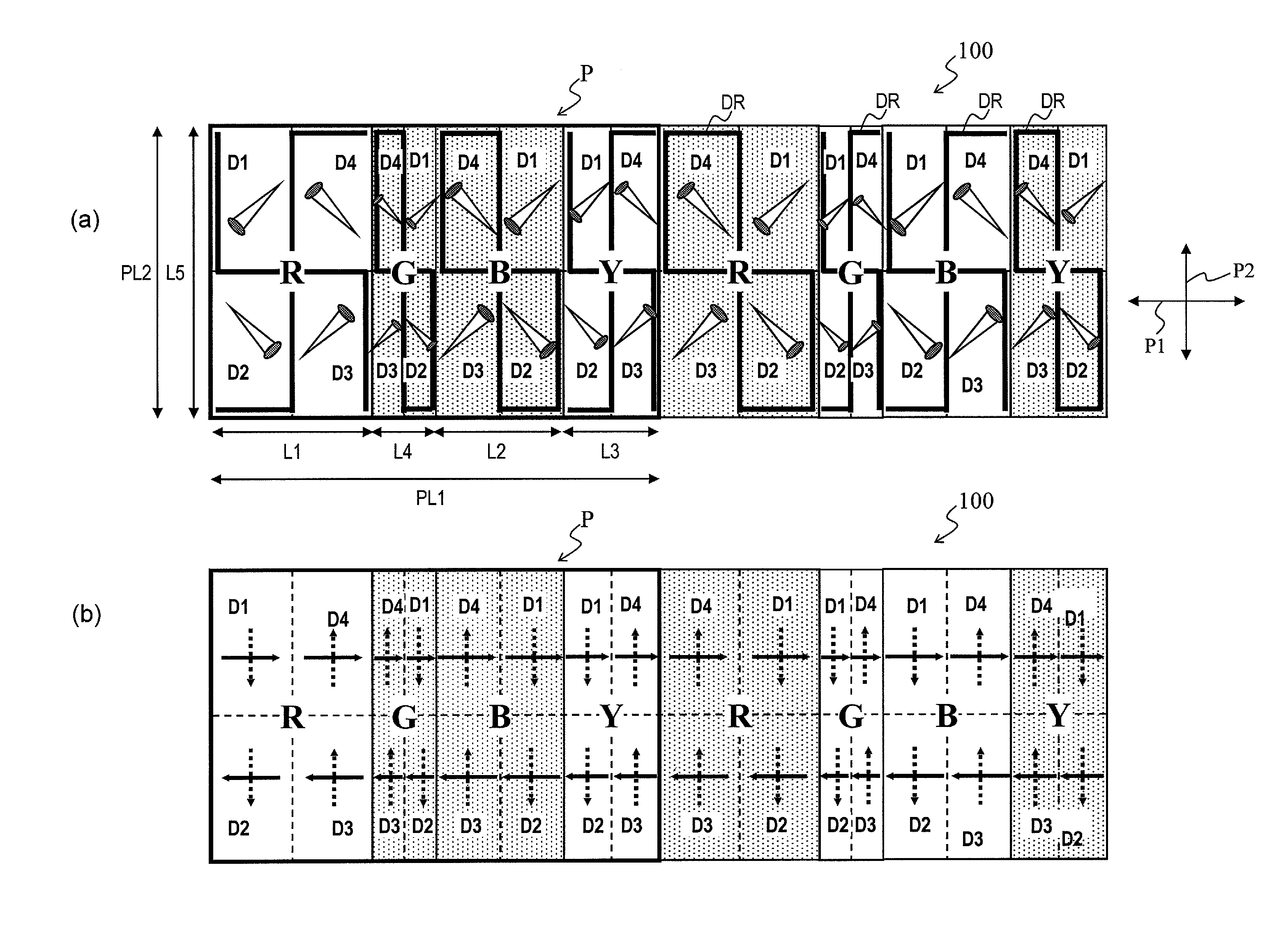Liquid crystal display device and manufacturing method therefor
a technology of liquid crystal display and manufacturing method, which is applied in the direction of microlithography exposure apparatus, instruments, photomechanical treatment, etc., can solve the problems of reducing display luminance and response speed distribution, and achieve the effect of suppressing the time and increasing the cost of optical alignment processing
- Summary
- Abstract
- Description
- Claims
- Application Information
AI Technical Summary
Benefits of technology
Problems solved by technology
Method used
Image
Examples
embodiment 1
[0158]Before describing this embodiment, a method for dividing one picture element of a general 4D-RTN mode into domains having different alignment directions, and a problem occurring when the 4D-RTN mode is adopted for a multiple primary color liquid crystal display device, will be described.
[0159]FIG. 1 shows a picture element 10 having a 4-domain alignment structure (4D structure). In FIG. 1, the picture element 10 is generally square in correspondence with a generally square picture element electrode for the sake of simplicity, but there is no limitation on the shape of the picture element. For example, the picture element 10 may be generally rectangular.
[0160]As shown in FIG. 1, the picture element 10 includes four liquid crystal domains D1, D2, D3 and D4. In FIG. 1, the liquid crystal domains D1, D2, D3 and D4 have an equal area size, and the example shown in FIG. 1 is the most preferable 4D structure from the viewpoint of viewing angle characteristics. The four liquid crystal...
embodiment 2
[0270]FIG. 44 shows a liquid crystal display device 200 in this embodiment. FIGS. 44(a) and (b) are each a plan view schematically showing four pixels P of the liquid crystal display device 200, which are continuous in the row direction.
[0271]As shown in FIGS. 44(a) and (b), all the four picture elements defining each pixel P have different lengths along the row direction. Specifically, a length L1 of the red picture element R along the row direction, a length L2 of the blue picture element B along the row direction, a length L3 of the yellow picture element Y along the row direction, and a length L4 of the green picture element G along the row direction are longer in this order (i.e., L1>L2>L3>L4). By contrast, all the picture elements have an equal length L5 along the column direction. In this manner, in the pixel P of the liquid crystal display device 200 in this embodiment, there is one length of picture elements in the column direction, whereas there are four lengths of picture...
embodiment 3
[0299]FIG. 51 shows a liquid crystal display device 300 in this embodiment. FIG. 51 is a plan view schematically showing six pixels P of the liquid crystal display device 300, which are continuous in the row direction.
[0300]As shown in FIG. 51, all the four picture elements defining each pixel P have different lengths along the row direction. Specifically, a length L1 of the red picture element R along the row direction, a length L2 of the blue picture element B along the row direction, a length L3 of the yellow picture element Y along the row direction, and a length L4 of the green picture element G along the row direction are longer in this order (i.e., L1>L2>L3>L4). By contrast, all the picture elements have an equal length L5 along the column direction. In this manner, in the pixel P of the liquid crystal display device 300 in this embodiment, there is one length of picture elements in the column direction, whereas there are four lengths of picture elements in the row direction....
PUM
 Login to View More
Login to View More Abstract
Description
Claims
Application Information
 Login to View More
Login to View More - R&D
- Intellectual Property
- Life Sciences
- Materials
- Tech Scout
- Unparalleled Data Quality
- Higher Quality Content
- 60% Fewer Hallucinations
Browse by: Latest US Patents, China's latest patents, Technical Efficacy Thesaurus, Application Domain, Technology Topic, Popular Technical Reports.
© 2025 PatSnap. All rights reserved.Legal|Privacy policy|Modern Slavery Act Transparency Statement|Sitemap|About US| Contact US: help@patsnap.com



